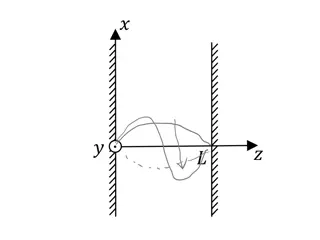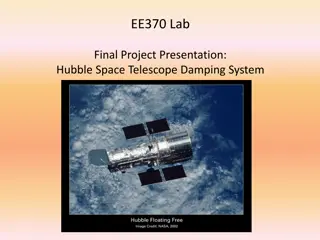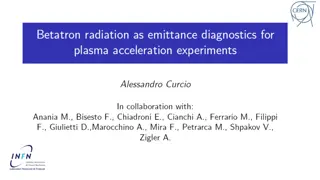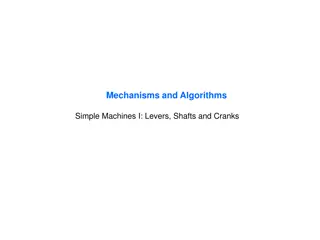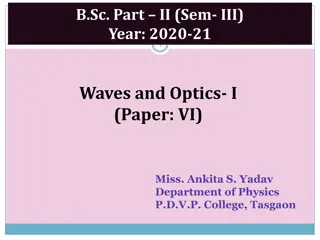Mechanical Ventilator Sensors and Actuators
Explore the essential components of mechanical ventilators, including sensors like pressure and flow sensors, actuators, and oxygen sensors. Learn about the functions and characteristics of these sensors and how they contribute to the operation of mechanical ventilators designed to assist patients w
6 views • 20 slides
Analog Computer Simulation of Mechanical Oscillations with Damping
Explore the analog computer simulation of mechanical oscillations with and without damping in a physics-themed project. Students can visualize classical physics concepts through hands-on analog circuit design, modeling spring-mass systems and RLC circuits. The project involves constructing a breadbo
1 views • 11 slides
Overview of Farm Power Sources and Utilization in Agriculture
Farm power sources in agriculture include human, animal, mechanical, and renewable energy. Human power is costly but versatile, while animal power is traditional and provides manure. Mechanical power from tractors and engines is efficient. India's farm power sources reflect a mix of traditional and
0 views • 12 slides
Quantum Aspects of Electromagnetic Oscillations
Exploring the quantum nature of electromagnetic oscillations through concepts such as wave-particle duality, quantum harmonic oscillators, photon-number states, coherent light, and squeezed light. Delve into non-classical states, vacuum states, potential wells, and more in the fascinating world of q
1 views • 15 slides
Hubble Space Telescope Damping System for Oscillation Reduction
This presentation focuses on the design and implementation of a compensator system to reduce deleterious oscillations affecting observations from the Hubble Space Telescope. Utilizing MATLAB for frequency response analysis, the project aims to dampen oscillations occurring at distinct frequencies, e
0 views • 12 slides
Force Transmissibility in Mechanical Systems
Force transmissibility in mechanical systems is crucial for analyzing the relationship between applied forces and resulting vibrations. This outline covers key concepts such as base excitation, motion transmissibility, and rotating unbalance, providing insights into how forces are transmitted and am
0 views • 16 slides
Oscillator Operation and Phase-Shift Oscillators
The use of positive feedback in a feedback amplifier with closed-loop gain greater than 1 can lead to oscillation, resulting in a varying output signal. Different types of oscillators, such as sinusoidal and pulse oscillators, are discussed along with the Barkhausen criterion for oscillation. The co
4 views • 23 slides
Mechanical Devices for Movement
Delve into the world of mechanical devices used to generate movement, focusing on levers as a critical mechanism for creating mechanical advantage. Learn about the different classes of levers, their applications, and how they enhance efficiency in various tools and equipment. Explore concepts such a
1 views • 8 slides
Introduction to Mechanical Engineering: Exploring Career Opportunities and Roles
This content delves into the world of mechanical engineering, covering topics such as the characteristics of students interested in engineering, the distinction between engineers and scientists, and the functions of engineers in research. It also provides insights into the differences between engine
7 views • 41 slides
Evolution of Arcade Games: From Mechanical to Digital (1870-1977)
Explore the fascinating journey of arcade games from mechanical and electro-mechanical devices in the 19th century to the birth of digital games in the mid-20th century. Witness the transition from coin-operated amusement machines to early digital arcade games and home consoles, shaping the gaming i
0 views • 37 slides
ME 4182 & GT 4823: High-profile Mechanical Design Course at Georgia Tech
Spearheading an innovative experiment, ME 4182 & GT 4823 aim to redefine mechanical design education by fostering interdisciplinary collaboration, problem-solving skills, and real-world applications. Students engage in team-based projects to design mechanical solutions, present detailed specificatio
0 views • 36 slides
Wavelet-based Scaleograms and CNN for Anomaly Detection in Nuclear Reactors
This study utilizes wavelet-based scaleograms and a convolutional neural network (CNN) for anomaly detection in nuclear reactors. By analyzing neutron flux signals from in-core and ex-core sensors, the proposed methodology aims to identify perturbations such as fuel assembly vibrations, synchronized
3 views • 11 slides
Department of Mechanical Engineering DAB Meeting Presentation Summary
The Department of Mechanical Engineering held a DAB Meeting Presentation on 23rd January, 2021. The meeting agenda included topics like approval of previous minutes of meeting, academic progress of students, online teaching activities, faculty contributions, and more. The minutes of the meeting disc
1 views • 36 slides
Mechanical Injuries: Types, Classification, and General Principles
Mechanical injuries encompass a variety of harms caused to the body, mind, reputation, or property. These injuries can be classified into medical, legal, and medico-legal categories based on factors like intentionality. The types of mechanical injuries range from blunt force trauma to thermal, chemi
0 views • 79 slides
Mechanical Ventilation in Anesthesia Practice
Anesthesia technologists play a crucial role in managing artificial ventilation, including concepts like Invasive Positive Mechanical Ventilation (IPMV), Fraction of Inspired Oxygen (FIO2), Tidal Volume (VT), Peak Flow Rate, Respiratory Rate, Minute Volume (VE), I:E Ratio, and more. They monitor and
1 views • 27 slides
Machines: Making Work Easier and Mechanical Advantage
Machines are devices that simplify work by increasing force, decreasing force, increasing distance, or changing direction. They operate by transferring energy and work from input to output, with mechanical advantage enhancing force ratios. This summary explores the principles of machines, work done,
1 views • 10 slides
Mechanical Ventilation in Anesthesia Technology
Mechanical ventilation plays a crucial role in assisting patients with breathing difficulties by delivering oxygen and removing carbon dioxide. It involves two primary types: Negative Pressure Ventilation (NPV) and Positive Pressure Ventilation (PPV). NPV helps patients with conditions like chronic
0 views • 19 slides
Newton's Interpolating Polynomials in Mechanical Engineering
Explore Newton's interpolating polynomials in the context of Mechanical Engineering, specifically focusing on numerical methods and interpolation techniques. Dr. Mohamed El-Shazly, an Associate Professor of Mechanical Design and Tribology, guides students through the concepts and applications of New
0 views • 17 slides
Plasma Acceleration and Betatron Oscillations Beam Characterization Method
The method for evaluating the quality of beams accelerated through plasma acceleration and betatron oscillations involves non-intercepting diagnostics to infer information about the electrons while inside the accelerating structure. It includes measuring the rms emittance and correcting the betatron
1 views • 12 slides
Surface Waves and Free Oscillations in Seismology
Exploring surface waves, potentials, and free oscillations in seismology with a focus on Rayleigh waves, Love waves, and wave equations. Understand the dispersion relation, geometry, and solutions for waves propagating in elastic half spaces and media with depth-dependent properties.
0 views • 55 slides
An Overview of Finite Element Method in Mechanical Engineering
Finite Element Method (FEM) in mechanical engineering is a powerful numerical technique involving dividing a domain into finite elements, establishing relations between variables, and assembling elements to analyze a system. This method is fundamental for solving one-dimensional problems and approxi
0 views • 63 slides
Mechanical Properties of Nanostructured Materials
Nanostructured materials exhibit unique mechanical properties due to factors like grain boundary structure and dislocation movement. Reduction in grain size can enhance strength and hardness while reducing ductility. Nanomaterials may reach theoretical strength levels, significantly higher than sing
0 views • 23 slides
Machines: Calculating Mechanical Advantage and Efficiency
In the world of machines, understanding what a machine is, how to calculate Mechanical Advantage (M.A.), and Efficiency is crucial. Machines alter force, distance, or direction to make work easier but do not multiply work. By assessing input force, distance, and work alongside output force, distance
0 views • 17 slides
Robotics and Mechanical Design at Minia University
Explore the world of robotics and mechanical design at Minia University's Production Engineering and Mechanical Design Department. From the Kinematics of Two Industrial Robots to the renowned PUMA 560, immerse yourself in cutting-edge technology and innovative research led by experts like Dr. Ahmed
0 views • 13 slides
Mechanical Linkages in High-Performance Manufacturing
Explore the world of mechanical linkages, including the effects of friction on machine operation, operation of machine linkages, and the roles of cams and turnbuckles. Friction is discussed as a force affecting everyday tasks, while cams and camshafts are highlighted for their role in sewing machine
0 views • 8 slides
Mechanical Ventilation in COPD Exacerbation
In a case of a 64-year-old woman with COPD exacerbation, managing respiratory distress is crucial. Initiating systemic corticosteroids, doxycycline, and nebulizers while closely monitoring the patient is important. However, in cases where non-invasive ventilation is ineffective, the patient may requ
0 views • 22 slides
Main Manufacturing Processes to Produce PM - Mechanical, Chemical, Electrochemical
The process of producing PM involves various manufacturing processes such as mechanical grinding and milling, physical-mechanical production methods, chemical production methods, and electrochemical production methods. Mechanical processes include grinding and milling using jaw crushers, hammer grin
0 views • 12 slides
Neutrino oscillations unlocked
Unlock the mysteries of neutrino oscillations in vacuum and other media, exploring wave packets, interference, entanglement, and oscillation probabilities. Dive into discussions on matter, vacuum, propagation, and time localization diagrams, shedding light on subtle quantum mechanical effects and te
0 views • 34 slides
Modeling Harmonic Oscillations and its Applications
Dive into the world of harmonic oscillations with a focus on the crucial damping coefficient. Explore simple undamped and damped harmonic motion, along with the analysis of mass-spring systems and bifurcations, all illustrated with informative visuals.
1 views • 16 slides
Chapter 14: Oscillations and Definitions in Physics
Delve into the world of oscillations with Chapter 14, exploring concepts like amplitude, period, and frequency in simple harmonic motion. Understand equations of motion for objects in periodic motion and discover how to calculate velocities and accelerations. Dive into the impact of changes in ampli
0 views • 36 slides
Diving into Neutrino Interactions and Oscillations
Exploring the intricate relationship between non-standard interactions and neutrino oscillations in core-collapse supernovae reveals the crucial role played by neutrinos. These elusive particles, with their unique ability to pass through matter, hold the key to understanding the dynamics of supernov
0 views • 17 slides
Simple Machines and Mechanics
Fascinating world of mechanisms and algorithms, delving into the principles of levers, shafts, and cranks. Discover the historical origins of automata and the fundamental laws of motion established by pioneers like Archimedes, Galileo, and Newton. Unveil the secrets behind the intricate mechanical m
0 views • 19 slides
Understanding Oscillations in Physics
Explore the world of oscillations through concepts like Simple Harmonic Oscillators (SHO), damped oscillations, underdamped and overdamped systems, critically damped oscillations, and more. Learn about the properties of waves, the wave equation, and electrical oscillations in RLC circuits.
0 views • 33 slides
Understanding Simple Harmonic Motion in Physics
Explore the fundamentals of oscillations and simple harmonic motion in physics, covering topics such as free oscillations, Hooke's Law, pendulum motion, and the characteristics of simple harmonic motion. Dive into the mathematical aspects and practical applications of this essential concept in physi
0 views • 30 slides
Understanding Coupled Pendulum Oscillations
Dive into the world of coupled pendulum oscillations, exploring the dynamics of two identical pendulums connected by a spring. Learn about the forces at play, equations of motion, and the effects of coupling on each pendulum's motion.
0 views • 40 slides
Physics Syllabus: Waves and Optics Concepts and Applications
Explore the fascinating topics of waves, optics, and acoustics in the B.Sc. Part II curriculum. Learn about harmonic oscillations, wave motion, ultrasonic waves, coupled oscillations, and acoustic principles like reverberation and intensity levels. Dive into the theoretical foundations and practical
0 views • 26 slides
Understanding Neutrino Oscillations: A Comprehensive Overview
Delve into the fascinating world of neutrino oscillations with this detailed exploration of the solar neutrino problem, flavor oscillation mechanisms, effective Hamiltonian modeling, and more. Discover the complexities behind neutrinos and their oscillatory nature in this informative resource.
0 views • 21 slides
Exploring Electric Braking: Types and Advantages
Dive into the world of electric braking with a detailed presentation covering the definition of braking, classification into mechanical and electrical braking, differences between mechanical and electric braking, disadvantages of mechanical braking, types of electric braking, and specifics of pluggi
0 views • 28 slides
Exploring Sterile Neutrinos and Their Impact on Long Baseline Experiments
Delve into the realm of sterile neutrinos and their influence on long baseline experiments, as young scientist Niki Klop sheds light on oscillations, motivations, and the intriguing anomalies observed in neutrino experiments. Explore the dynamic interplay between mass eigenstates, neutrino flavor tr
0 views • 18 slides
Exploring Oscillations in Physical Science with Robert Wagner
Dive into the world of oscillations in physical science with Robert Wagner as your guide. Understand the forces behind objects oscillating and calculate force constants for suspension systems and spring potentials. Learn about elastic potential energy and its applications in real-world examples like
0 views • 10 slides



